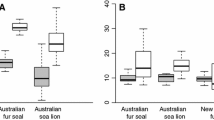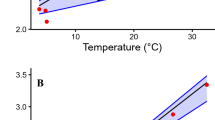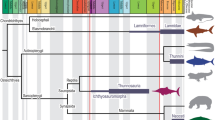Abstract
Cardiac morphology and mass have been associated with activity levels for bony fishes and elasmobranchs; however, there is little information on cardiac morphology of deep-sea sharks (living primarily below 200 m) and how that morphology compares to cardiac morphology of shallow coastal species. We examined relative heart mass and relative ventricle dry mass in 10 species of sharks from coastal to bathydemersal habitats (23–870 m) to test our hypothesis that relative heart mass decreases with depth. Relative heart mass and relative ventricle dry mass decreased with increasing depth of capture for sharks. The coastal, obligate ram ventilator Carcharhinus limbatus had the highest relative heart mass (1.17 g/kg) and relative ventricle dry mass (0.18 g/kg), whereas the deep-sea species Centrophorus uyato had the lowest (relative heart mass, 0.34 g/kg; relative ventricle dry mass, 0.057 g/kg). Our findings of decreasing relative heart and ventricle size with increasing depth support the visual interaction hypothesis as an explanation for reduced metabolic capacity in deep-sea sharks.



Similar content being viewed by others
Data availability
The data in this study are available with reasonable request from the corresponding author at melarsen@coastal.edu or matt.larsen@knights.ucf.edu.
References
Bernal D, Sepulveda C, Mathieu-Costello O, Graham JB (2003) Comparative studies of high-performance swimming in sharks I Red muscle morphometrics, vascularization and ultrastructure. J Exper Biol 206(16):2831–2843
Bethea DM, Buckel JA, Carlson JK (2004) Foraging ecology of the early life stages of four sympatric shark species. Mar Ecol Prog Ser 268:245–264
Blaxter JHS, Wardle CS, Roberts BL (1971) Aspects of the circulatory physiology and muscle systems of deep-sea fish. J Marine Biol Assoc UK 51(4):991–1006
Brill R, Chin Lai N (2015) Elasmobranch cardiovascular system. In: Shadwick RE, Farrell AP, Brauner CJ (eds) Fish physiology, vol 34B. Physiology of Elasmobranch Fishes – Internal Processes. Academic Press, San Diego, pp 2–83
Carlson JK, Palmer CL, and Parsons GR (1999) Oxygen consumption rate and swimming efficiency of the blacknose shark, Carcharhinus acronotus. Copeia 34–39
Childress JJ (1995) Are there physiological and biochemical adaptations of metabolism in deep-sea animals? Trends Ecol Evol 10(1):30–36
Childress JJ, Somero GN (1990) Metabolic scaling: a new perspective based on scaling of glycolytic enzyme activities. Am Zool 30(1):161–173
Churchill DA, Heithaus MR, Vaudo JJ, Grubbs RD, Gastrich K, Castro JI (2015) Trophic interactions of common elasmobranchs in deep-sea communities of the Gulf of Mexico revealed through stable isotope and stomach content analysis. Deep-sea Res Part II 115:92–102
Condon NE, Friedman JR, Drazen JC (2012) Metabolic enzyme activities in shallow-and deep-water chondrichthyans: implications for metabolic and locomotor capacity. Mar Biol 159(8):1713–1731
Cortes E, Manire CA, Hueter RE (1996) Diet, feeding habits, and diel feeding chronology of the bonnethead shark, Sphyrna tiburo, in southwest Florida. Bull Mar Sci 58(2):353–367
Cotton CF, Grubbs RD (2015) Biology of deep-water chondrichthyans: Introduction. Deep-sea Res Part II 115:1–10
Davie PS, Farrell AP (1991a) Cardiac performance of an isolated heart preparation from the dogfish (Squalus acanthias): the effects of hypoxia and coronary artery perfusion. Can J Zool 69(7):1822–1828
Davie PS, Farrell AP (1991b) The coronary and luminal circulations of the myocardium of fishes. Can J Zool 69(7):1993–2001
Davies AJ, Roberts JM, Hall-Spencer J (2007) Preserving deep-sea natural heritage: emerging issues in offshore conservation and management. Biol Conserv 138(3–4):299–312
Drazen JC, Seibel BA (2007) Depth-related trends in metabolism of benthic and benthopelagic deep-sea fishes. Limnol Oceanogr 52(5):2306–2316
Emery SH (1986) Hematological comparisons of endothermic vs ectothermic elasmobranch fishes. Copeia 700–705
Emery SH, Mangano C, Randazzo V (1985) Ventricle morphology in pelagic elasmobranch fishes. Comparative biochemistry and physiology. Comp Physiol 82(3):635–643
Farrell AP (1991) From hagfish to tuna: a perspective on cardiac function in fish. Physiol Zool 64(5):1137–1164
Farrell AP, Jones DR (1992) The heart. Cardiovasc Syst 12:1–88
Gelsleichter J, Musick JA, Nichols S (1999) Food habits of the smooth dogfish, Mustelus canis, dusky shark, Carcharhinus obscurus, Atlantic sharpnose shark, Rhizoprionodon terraenovae, and the sand tiger, Carcharias taurus, from the northwest Atlantic Ocean. Environ Biol Fishes 54(2):205–217
Grim JM, Ding AA, Bennett WA (2012) Differences in activity level between cownose rays (Rhinoptera bonasus) and Atlantic stingrays (Dasyatis sabina) are related to differences in heart mass, hemoglobin concentration, and gill surface area. Fish Physiol Biochem 38(5):1409–1417
Heinicke MP, Naylor GJP, Hedges SB (2009) Cartilaginous fishes (Chondrichthyes). Timetree Life 9:320–327
Kyne PM, Simpfendorfer CA (2010) Deepwater chondrichthyans. In: Carrier JC, Musick JA, Heithaus MR (eds) Sharks and their relatives II. Biodiversity, adaptive physiology, and conservation. pp 37–113
Lai NC, Korsmeyer KE, Katz S, Holts DB, Laughlin LM, Graham JB (1997) Hemodynamics and blood properties of the shortfin mako shark (Isurus oxyrinchus). Copeia 1997(2):424–428
Murawski SA, Hogarth WT, Peebles EB, Barbeiri L (2014) Prevalence of external skin lesions and polycyclic aromatic hydrocarbon concentrations in Gulf of Mexico fishes, post-Deepwater Horizon. Trans Am Fish Soc 143(4):1084–1097
Parsons GR (1990) Metabolism and swimming efficiency of the bonnethead shark Sphyrna tiburo. Mar Biol 104(3):363–367
Peterson CT, Grubbs RD, Mickle A (2017) An investigation of effects of the deepwater horizon oil spill on coastal fishes in the Florida big bend using fishery-independent surveys and stable isotope analysis. Southeastern Nat 16:1
Pinte N, Parisot P, Martin U, Zintzen V, De Vleeschouwer C, Roberts CD, Mallefet J (2020) Ecological features and swimming capabilities of deep-sea sharks from New Zealand. Deep-sea Res Part I 156:103187
Plumlee JD, Wells RD (2016) Feeding ecology of three coastal shark species in the northwest Gulf of Mexico. Mar Ecol Prog Ser 550:163–174
Poupa O (1972) Heart under unusual conditions: Effects of gravitation and chronic hypoxia. Rec Adv Stud Cardiac Struct Metab 1:779
Poupa O, Lindström L (1983) Comparative and scaling aspects of heart and body weights with reference to blood supply of cardiac fibers. Comp Biochem Physiol A Physiol 76(3):413–421
Priede IG (2017) Deep-sea fishes: biology, diversity, ecology and fisheries. Cambridge University Press
Rigby C, Simpfendorfer CA (2015) Patterns in life history traits of deep-water chondrichthyans. Deep-sea Res Part II 115:30–40
Rountree RA, Able KW (1996) Seasonal abundance, growth, and foraging habits of juvenile smooth dogfish, Mustelus canis, in a New Jersey estuary. Fish Bull 94(3):522–534
Satchell GH (1999) Circulatory System. In: Hammett WC (ed) Sharks, skates, and rays. John Hopkins University Press, Baltimore, MD, pp 218–237
Schmidt-Nielsen K (1979) Animal physiology, 2nd edn. Cambridge University Press, London
Seibel BA, Drazen JC (2007) The rate of metabolism in marine animals: environmental constraints, ecological demands and energetic opportunities. Philosop Transactions Royal Soc B Biol Sci 362(1487):2061–2078
Seibel BA, Thuesen EV, Childress JJ (2000) Light-limitation on predator-prey interactions: consequences for metabolism and locomotion of deep-sea cephalopods. Biol Bull 198(2):284–298
Sepulveda CA, Graham JB, Bernal D (2007) Aerobic metabolic rates of swimming juvenile mako sharks Isurus oxyrinchus. Mar Biol 152(5):1087–1094
Sorenson L, Santini F, Alfaro ME (2014) The effect of habitat on modern shark diversification. J Evol Biol 27(8):1536–1548
Speers-Roesch B, Brauner CJ, Farrell AP, Hickey AJ, Renshaw GM, Wang YS, Richards JG (2012) Hypoxia tolerance in elasmobranchs. II. Cardiovascular function and tissue metabolic responses during progressive and relative hypoxia exposures. J Exp Biol 215(1):103–114
Treberg JR, Martin RA, Driedzic WR (2003) Muscle enzyme activities in a deep-sea squaloid shark, Centroscyllium fabricii, compared with its shallow-living relative, Squalus acanthias. J Exp Zool Part A Comp Exp Biol 300(2):133–139
Underwood CJ (2006) Diversification of the Neoselachii (Chondrichthyes) during the Jurassic and Cretaceous. Paleobiology 32(2):215–235
Walker MG, Santer RM, Benjamin M, Norman D (1985) Heart structure of some deep-sea fish (Teleostei: Macrouridae). J Zool 205(1):75–89
Acknowledgements
We acknowledge Coastal Carolina University and the Florida State University Coastal and Marine Laboratory for all of the support while undertaking this research. Both of these institutions contributed to the completion of this research. We acknowledge the Coastal Carolina University Shark Research Project and volunteers for their assistance processing samples over the course of this study. We also thank Dr. Scott Parker for the use of equipment and laboratory space during this study. Additionally, we would like to acknowledge the contribution of undergraduate students David Klett and Sarah Gregory of Coastal Carolina University for their assistance. We also acknowledge the Deep-C consortium and the Gulf of Mexico Research Initiative (GoMRI) for funding to collect the deep-sea shark samples.
Author information
Authors and Affiliations
Contributions
M.E.L. and D.C.A. developed the initial research question. M.E.L., D.C.A., and R.D.G. developed a hypothesis based on the initial research idea. M.E.L. collected the heart morphology measurements. M.E.L. completed statistical analysis with the help of D.P.C. M.E.L., D.C.A., and R.D.G. contributed to collecting and preparing samples. All authors contributed to interpretation of the results. M.E.L. was lead author for the manuscript. All authors provided feedback that contributed to the development of this manuscript from an initial research question.
Corresponding author
Ethics declarations
Conflict of interest
The authors confirm that they have no conflicts of interest.
Human and animal rights
All shark collection and handling procedures were approved by the Coastal Carolina University Institutional Animal Care and Use Committee (#2012.04) and Florida State University Institutional Animal Care and Use Committee (#1708 and 1718).
Additional information
Responsible Editor: J. Carlson.
Publisher's Note
Springer Nature remains neutral with regard to jurisdictional claims in published maps and institutional affiliations.
Reviewed by J. Drazen and J. Grim.
Rights and permissions
About this article
Cite this article
Larsen, M.E., Abel, D.C., Crane, D.P. et al. Differences in relative heart mass among deep-sea and coastal sharks with increasing depth. Mar Biol 167, 169 (2020). https://doi.org/10.1007/s00227-020-03780-0
Received:
Accepted:
Published:
DOI: https://doi.org/10.1007/s00227-020-03780-0




